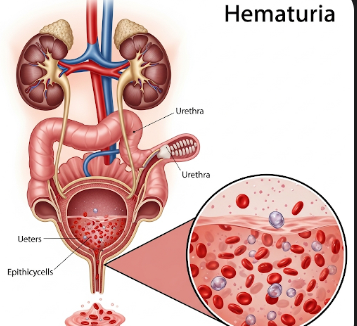Overview
Haematuria is the presence of blood in the urine, which can range from visible red or brown urine (gross haematuria) to microscopic amounts detectable only by laboratory tests (microscopic haematuria). It is a clinical sign rather than a disease itself and may indicate urinary tract infections, kidney disorders, trauma, or malignancies.
In South Korea, urology clinics and hospitals provide comprehensive evaluation, advanced imaging, and treatment options for haematuria, ensuring timely diagnosis and management to prevent complications.
Key Facts
🟢 ➤ Haematuria is classified as gross (visible) or microscopic (lab-detected).
🟢 ➤ Causes range from urinary tract infections, kidney stones, and trauma to cancers of the urinary system.
🟢 ➤ Symptoms may include red, pink, or cola-colored urine, pain, or urinary urgency.
🟢 ➤ Early detection and evaluation are important to identify serious underlying conditions.
🟢 ➤ Diagnostic tests include urinalysis, urine culture, imaging, and cystoscopy.
🟢 ➤ South Korean urology centers offer advanced diagnostic tools and minimally invasive treatments.
What is Haematuria?
Haematuria occurs when blood is present in the urine, arising from any part of the urinary tract: kidneys, ureters, bladder, or urethra.
Key points:
➤ Gross haematuria: visible blood causing pink, red, or cola-colored urine.
➤ Microscopic haematuria: detectable only under a microscope or via urine dipstick testing.
➤ May be transient or persistent, and can be associated with pain or urinary symptoms depending on the cause.
➤ While sometimes benign, haematuria can indicate serious conditions like kidney disease or urinary tract cancer, necessitating prompt evaluation.
Symptoms Related to Haematuria
Symptoms depend on cause and severity:
🟢 ➤ Visible blood in urine (gross haematuria) or urine that appears tea-colored or cola-colored.
🟢 ➤ Sometimes painless, particularly in bladder or kidney cancers.
🟢 ➤ Painful urination or burning sensation, especially with urinary tract infections.
🟢 ➤ Flank pain or abdominal pain if associated with kidney stones or trauma.
🟢 ➤ Increased urinary frequency or urgency in infections or bladder irritation.
🟢 ➤ Fever or systemic symptoms may appear in cases of infection.
Causes / Possible Causes
Haematuria has multiple potential causes, ranging from benign to serious conditions:
Urinary Tract Infections (UTIs)
➤ Bacterial infections can irritate the urinary tract, causing bleeding.
Kidney and Urinary Tract Stones
➤ Stones may scratch the lining of the urinary tract, causing visible blood and pain.
Trauma or Injury
➤ Direct injury to the kidneys, ureters, bladder, or urethra can cause haematuria.
Kidney Disorders
➤ Glomerulonephritis, polycystic kidney disease, or other renal pathologies may lead to microscopic or gross haematuria.
Cancers
➤ Bladder, kidney, or urethral cancer can present with painless haematuria.
Medications
➤ Blood thinners (anticoagulants) or certain antibiotics may contribute to haematuria.
Other Causes
➤ Vigorous exercise, menstrual contamination in females, or congenital abnormalities.
When Should I See a Doctor?
Consult a healthcare provider if:
🟢 ➤ Blood is visible in urine (gross haematuria), even if painless.
🟢 ➤ Haematuria persists or recurs.
🟢 ➤ Accompanied by pain, fever, or urinary symptoms.
🟢 ➤ There is a history of trauma, kidney disease, or cancer risk factors.
Early evaluation ensures timely diagnosis of serious conditions, including cancers, kidney disorders, or infections.
Care and Treatment
Management of haematuria depends on underlying cause and severity:
Medical Management
➤ Antibiotics for urinary tract infections.
➤ Pain relief and hydration for kidney stones.
➤ Adjustment of medications if drugs contribute to bleeding.
Procedures and Surgical Interventions
➤ Lithotripsy or ureteroscopy for kidney stones.
➤ Cystoscopy to examine the bladder lining and identify tumors or lesions.
➤ Surgical removal of tumors or obstructive lesions if necessary.
Lifestyle and Supportive Care
➤ Adequate hydration to flush the urinary tract.
➤ Avoidance of excessive strenuous activity if it triggers haematuria.
➤ Regular follow-up and monitoring for recurrent or unexplained bleeding.
Advanced Care in Korea
➤ South Korean urology centers provide comprehensive diagnostic evaluation, including imaging (ultrasound, CT, MRI) and cystoscopy.
➤ Multidisciplinary care includes urologists, nephrologists, and oncologists for individualized treatment plans.
➤ Patient education programs help manage underlying conditions, monitor recurrence, and improve long-term outcomes.
Highlights (Clean Green Arrow Version)
🟢 ➤ Haematuria is the presence of blood in the urine, either visible (gross) or microscopic.
🟢 ➤ Symptoms: red, pink, or tea-colored urine, pain, urinary urgency, and sometimes systemic signs like fever.
🟢 ➤ Causes: infections, kidney stones, trauma, kidney disorders, medications, or urinary tract cancers.
🟢 ➤ Early evaluation is critical to rule out serious conditions and prevent complications.
🟢 ➤ Treatment includes antibiotics, pain management, procedures for stones, cystoscopy, or surgery depending on cause.
🟢 ➤ South Korea offers advanced urology care with integrated diagnostic, medical, and surgical management.













